#inaash
Text
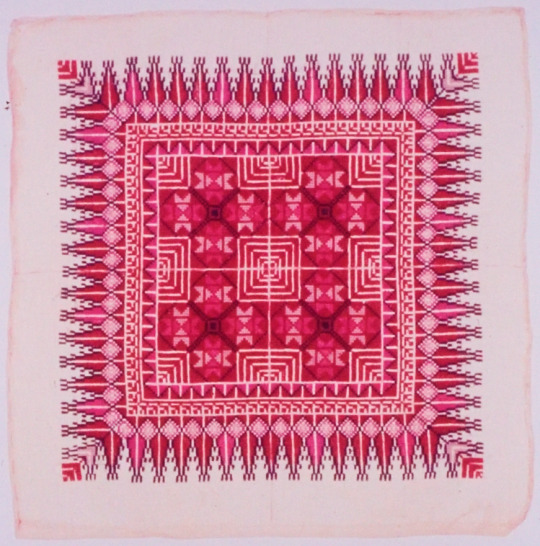
Handmade piece embroidered by Palestinian refugee women, INAASH Association for the Development of Palestinian Camps, Lebanon, 1970s [The Association for the Development of Palestinian Camps Collection, The Palestinian Museum Digital Archive, The Palestinian Museum, Birzeit]
#art#design#embroidery#geometry#pattern#inaash#association for the development of palestinian camps#huguette caland#the palestinian museum digital archive#the palestinian museum#1970s
459 notes
·
View notes
Text
The power of a pattern. What design can teach us about culture

Material Power: Palestinian Embroidery, will explore the historical life and contemporary significance of the Palestinian embroidered dress.
Although an ancient craft, embroidery remains the paradigmatic cultural material of Palestine today and its most prominent living tradition.
This exhibition will be held Friday 24 November 2023 – 7th April 2024 at the Whitworth Art Gallery, Oxford Road, Manchester.

Apparently, the Palestinian dress differs from one region to another and according to the occasion on which the dress is worn. In the north where wheat is grown, ears of corn were the most important characteristic of the dresses.
In Hebron and Bethlehem, the trend was grape drawings. The color and inscriptions of the dresses differed depending on the occasion. At weddings, dresses differed from casual, everyday ones. Widows wore different dresses as well.
In 2022, Maha el-Saca, a researcher at the Palestinian Heritage Center, explained to Al-Monitor that Palestinians also recognize the cities or villages of women from their dresses.
"The Jaffa dress is embroidered in the form of oranges and the cypress trees that surrounded it, while the Canaanite dress in Jericho had geometric drawings."
According to Marwan Abu Khalaf, a researcher of Palestinian heritage at Inaash Al-Usra Association, Palestinian embroidery was implicitly known to be Palestinian and incorporates "decorations and drawings dating back to the Canaanite era 3,000 years ago."
#manchester#iraq#iraqi#uk#london#baghdad#liverpool#scotland#design#creative#world history#history#culture#archaeology#art history#artwork#middle east#roman catholic church#catholic#catholiscism#catholism
2 notes
·
View notes
Photo

Colorful belts to suit everyone’s taste. Impeccably embroidered, and with a leather finish, the Inaash belt brings a touch of distinction to any outfit.
Enjoy mixing and matching this perfect addition to your wardrobe to elevate your outfits into lively, unique, stylish, and empowering looks that will definitely make you stand out in the crowd!
0 notes
Text
89 Organizations denounce Turkey’s Repeated Water cut to Hundreds of Thousands of People in Syria’s North East
For the eighth time, Turkey and affiliated local councils use water to blackmail in COVID-19 pandemic
On 13 August 2020, Turkish forces turned off the Alok water pumping station, under their control, to hundreds of thousands of people in northeastern Syria, just as they did earlier repeatedly in March, April and July and that was also followed by a frequent lack of water pumping.
The Alok water pumping station, which is located east of the city of Ras al-Ayn/Serê Kaniyê and has 30 wells, which can pump up to 175.000 cubic meters per day, supplies drinkable water to around 800.000 people besides being the main source to fill the tanker trucks that carry water to the makeshift camps of al-Hawl, al-Areesha (or al-Sadd) and Washo Kani (or al-Twaina), according to the International Committee of the Red Cross (ICRC).
Sporadic water cut forced the population of Syria’s north east to rely on unsafe alternatives, endangering their lives on top of their fight against COVID-19, that has infected 280 and killed 17 in northeastern Syria so far, according to the last update by the health authority of the Autonomous Administration on 20 August 2020. Suspending the Alok water station puts the lives of hundreds of thousands of people at risk, since washing hands with water and soup is essential to protect themselves against the pandemic.
Turkey and affiliated local councils claim that the forces in control of the Tishrin Dam interrupted power to the Alok water station causing its stop. However, that was refuted by observatory impartial organizations, among them the Human Rights Watch (HRW), which confirmed in a report that the Mabrouka power station does not supply the Alok pumping station and that the latter has alternative power sources enough to operate it.
Signatories of this statement condemn the repeated suspensions of the Alok water pumping station by Turkey and associated local councils, who continue to use it to blackmail. We also would like to recall that this deliberate denial of water to the population is a flagrant violation to their basic right to access clean water and to the international humanitarian law; it also constitutes a war crime,
Accordingly, the signatories of this statement call on the United Nations (UN), the Security Council, the World Health Organization (WHO), the United Nation International Children’s Emergency Fund (UNICEF), the United Nations Office for the Coordination of Humanitarian Affairs (OCHA), the High Commissioner for Human Rights (OHCHR), the United States Government, the European Union, the International Committee of the Red Cross (ICRC) and the United Nations High Commissioner for Refugees (UNHCR) to:
Pressure Turkey and affiliated local councils to resume the Alok water station urgently and immediately, and ensure that there would be no repetition of such cuts under any pretext.
Neutralize the Alok water station from political and military conflicts by suspending Turkey and other parties from using it to blackmail, and to hire a specialized and independent management team to run it under international supervision and control.
Ensure that all population in Syria’s north east benefit from water and other natural resources fairly and equitably without discrimination of any kind, under impartial international supervision.
Investigate into the repeated water cuts transparently and independently, and thus hold those involved accountable whoever they were.
The Statement Signatories;
1. Aata’a Organization for Development
2. Adel Center for Human Right
3. Al Diyar Society
4. Aljazera Relief Organisation
5. Anoar Algad Organization
6. Aras Charity Association
7. ASHNA for Development
8. Ashna Organization for Development
9. Ashti Center for Peacebuilding
10. ASO - Center for Consultancy and Strategic Studies
11. Ata'a Al-Baghouz Association for Development
12. Atyaf Organization
13. Baladna Organization for Civil Society
14. Balsam Center for Health Education
15. Better Hope for Tabqa
16. Bonus without Borders
17. Bukra Ahla Association for Relief and Development
18. Civil Society Institutions Platform in Northern and Eastern Syria
19. DAN for Relief and Development
20. Dawlaty
21. Demos Organization
22. DOZ – Syria
23. DREAM - Hlom for Development
24. EMAAR MANSURA
25. Ensaf for Development
26. Euphrates Organization for Relief and Development – EORD
27. Ezdina Organisation
28. Field Response Team
29. Forum Tow Rivers Organization
30. GAV for Relief and Development
31. Hajin Technicians Organization
32. Hdf humanitarian Organization
33. Hevy for Relief and Development
34. HOPE MAKERS
35. Hope Smile - Al Fourat
36. House of Citizenship Organization
37. Human Hope Team
38. Human Rights Organisation in Syria – MAF
39. Inaash Organization for Development
40. Inmaa alfourt Organization
41. International War and Disaster Victims Protection Association – IPV
42. Jan Center for the Care and Training of Children with Special Needs
43. Jasmine Association – Raqqa
44. Jian Charitable Society
45. Jinar for Aid and Development
46. Jiyan Foundation for Human Rights – JFHR
47. Jomard Charity Association – JCA
48. Judy Charity for Development and Relief
49. Justice and Building Center
50. Khwtwa Association for Relief and Development – Raqqa
51. Kobani for Relief and Development
52. Kurdish Committee for Human Rights – RASED
53. Kurdish Legal Committee -KLC
54. Kurdish Organisation for Human rights in Syria – DAD
55. Land of peace Organization
56. Lawir Organization for Animal Protection
57. Legal Construction Organization
58. Life for Syrian Association
59. Mahabad Organization for Human Rights – MOHR
60. Mitan Center to Revive Civil Society
61. NABD Team
62. Nour Jan Charitable Society in Amouda
63. Nujîn - Nujeen Association for Community Development
64. PÊL- Civil Waves
65. People for Human Development – PHD
66. ROJ KAR - for Relief and Development
67. SARA Organization to Combat Violence Against Women
68. Shamal Charity Association
69. SHAMS Organization
70. Shar for Development
71. Share for Community Development
72. Shawishka Association
73. Shaylan Association for Relief and Development
74. Slav Center for Civic Activities
75. Smile Organization
76. Swaaed for Development
77. Swaedna Organization for relief and Development
78. Syrian Kurdish civil Forces Gathering
79. Syrian Kurdish Journalists Network – SKJN
80. Syrians for Truth and Justice-STJ
81. TEVNA KURDI
82. The Civil Cooperation Team Organization
83. The Four Seasons Organization
84. TOTOL FOUNDATION for Relaif and Development
85. Violations Documentation Center in Northern Syria – VDCNSY
86. Women for Peace Organization
87. Xunav Association for Relief and Development
88. Youth for Change
89. Zakon Association - Komîteya Zagon
For more information or to provide feedback and opinions, please contact TEVN via email.
also You can follow us on Twitter and Facebook . And subscribe to our newsletter to receive updates about the TEVN's work.
0 notes
Photo

Mona Hatoum with Inaash, 12 Windows, 2012-13
Inaash, the Association for the Development of Palestinian Camps, is an NGO founded in the late 1960s by a group of Lebanese and Palestinian women. Its goal is twofold: to preserve the heritage of traditional Palestinian embroidery, and to provide financial support for Palestinian refugee families in Lebanon. From the Inaash website (linked above):
12 Windows... is intended to encapsulate the story of Palestine. The culmination of over 40 years of dedicated research and design by Malak Abdulrahim, the 1.0 meter square panels were meticulously embroidered by Inaash's most experienced craftswomen. Seen together, the twelve panels form a symbolic map of Palestine. Through the accurate selection of specific motifs, stitches and patterns, each window represents a key region: upper and lower Galilee, Jaffa, Ramallah, Bethlehem and Jerusalem, Hebron, coastal and central Gaza and Beersheba in southern Palestine. Together they create a wonderfully vibrant insight into a now dispersed society
#Mona Hatoum#inaash#palestine#arab art#palestinian art#palestinian embroidery#contemporary art#needlework#palestinian pride#palestinian heritage#jaffa#ramallah#galilee#bethlehem#jerusalem
37 notes
·
View notes
Text

Handmade piece embroidered by Palestinian refugee women, INAASH Association for the Development of Palestinian Camps, Lebanon, 1970s [The Association for the Development of Palestinian Camps Collection, The Palestinian Museum Digital Archive, The Palestinian Museum, Birzeit]
#art#design#embroidery#geometry#pattern#inaash#association for the development of palestinian camps#huguette caland#the palestinian museum digital archive#the palestinian museum#1970s
655 notes
·
View notes
Text

Handmade piece embroidered by Palestinian refugee women, INAASH Association for the Development of Palestinian Camps, Lebanon, 1970s [The Association for the Development of Palestinian Camps Collection, The Palestinian Museum Digital Archive, The Palestinian Museum, Birzeit]
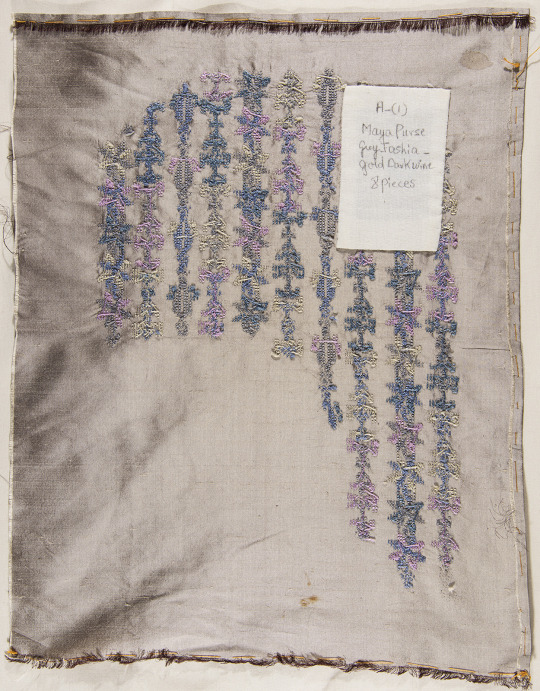
#art#design#embroidery#geometry#pattern#notation#inaash#association for the development of palestinian camps#huguette caland#the palestinian museum digital archive#the palestinian museum#1970s
295 notes
·
View notes
Text
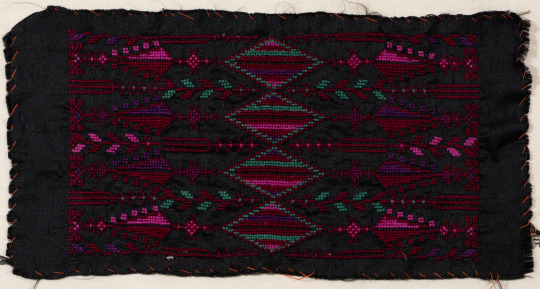
Handmade piece embroidered by Palestinian refugee women, INAASH Association for the Development of Palestinian Camps, Lebanon, 1970s [The Association for the Development of Palestinian Camps Collection, The Palestinian Museum Digital Archive, The Palestinian Museum, Birzeit]
#art#design#embroidery#geometry#pattern#inaash#association for the development of palestinian camps#huguette caland#the palestinian museum digital archive#the palestinian museum#1970s
141 notes
·
View notes
Text
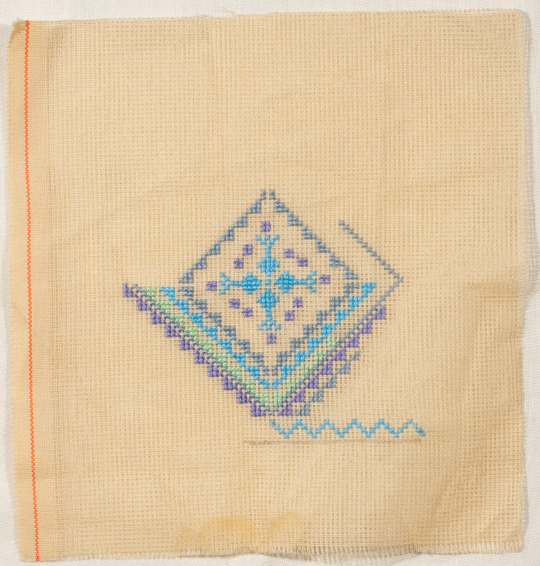
Handmade piece embroidered by Palestinian refugee women, INAASH Association for the Development of Palestinian Camps, Lebanon, 1970s [The Association for the Development of Palestinian Camps Collection, The Palestinian Museum Digital Archive, The Palestinian Museum, Birzeit]
#art#design#embroidery#geometry#pattern#inaash#association for the development of palestinian camps#huguette caland#the palestinian museum digital archive#the palestinian museum#1970s
44 notes
·
View notes
Text
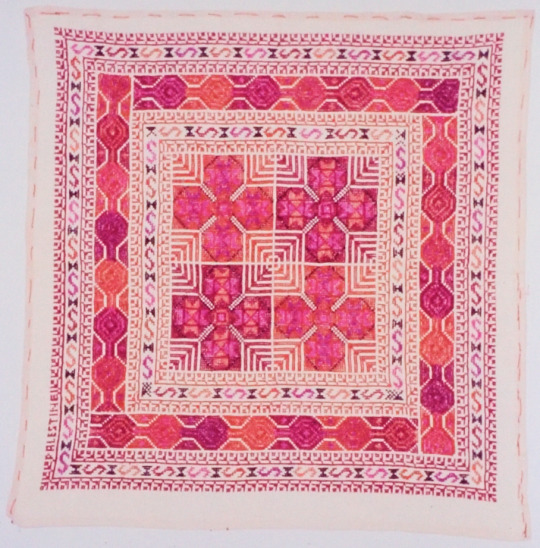
Handmade piece embroidered by Palestinian refugee women, INAASH Association for the Development of Palestinian Camps, Lebanon, 1970s [The Association for the Development of Palestinian Camps Collection, The Palestinian Museum Digital Archive, The Palestinian Museum, Birzeit]
#art#design#embroidery#geometry#pattern#inaash#association for the development of palestinian camps#huguette caland#the palestinian museum digital archive#the palestinian museum#1970s
25 notes
·
View notes
Text

Handmade piece embroidered by Palestinian refugee women, INAASH Association for the Development of Palestinian Camps, Lebanon, 1970s [The Association for the Development of Palestinian Camps Collection, The Palestinian Museum Digital Archive, The Palestinian Museum, Birzeit]
#art#design#embroidery#geometry#pattern#inaash#association for the development of palestinian camps#huguette caland#the palestinian museum digital archive#the palestinian museum#1970s
46 notes
·
View notes
Text

Handmade piece embroidered by Palestinian refugee women, INAASH Association for the Development of Palestinian Camps, Lebanon, 1970s [The Association for the Development of Palestinian Camps Collection, The Palestinian Museum Digital Archive, The Palestinian Museum, Birzeit]
#art#design#embroidery#geometry#pattern#inaash#association for the development of palestinian camps#huguette caland#the palestinian museum digital archive#the palestinian museum#1970s
32 notes
·
View notes
Text

Handmade piece embroidered by Palestinian refugee women, INAASH Association for the Development of Palestinian Camps, Lebanon, 1970s [The Association for the Development of Palestinian Camps Collection, The Palestinian Museum Digital Archive, The Palestinian Museum, Birzeit]
#art#design#embroidery#geometry#pattern#inaash#association for the development of palestinian camps#huguette caland#the palestinian museum digital archive#the palestinian museum#1970s
37 notes
·
View notes
Text

Handmade piece embroidered by Palestinian refugee women, INAASH Association for the Development of Palestinian Camps, Lebanon, 1970s [The Association for the Development of Palestinian Camps Collection, The Palestinian Museum Digital Archive, The Palestinian Museum, Birzeit]
#art#design#embroidery#geometry#pattern#inaash#association for the development of palestinian camps#huguette caland#the palestinian museum digital archive#the palestinian museum#1970s
16 notes
·
View notes